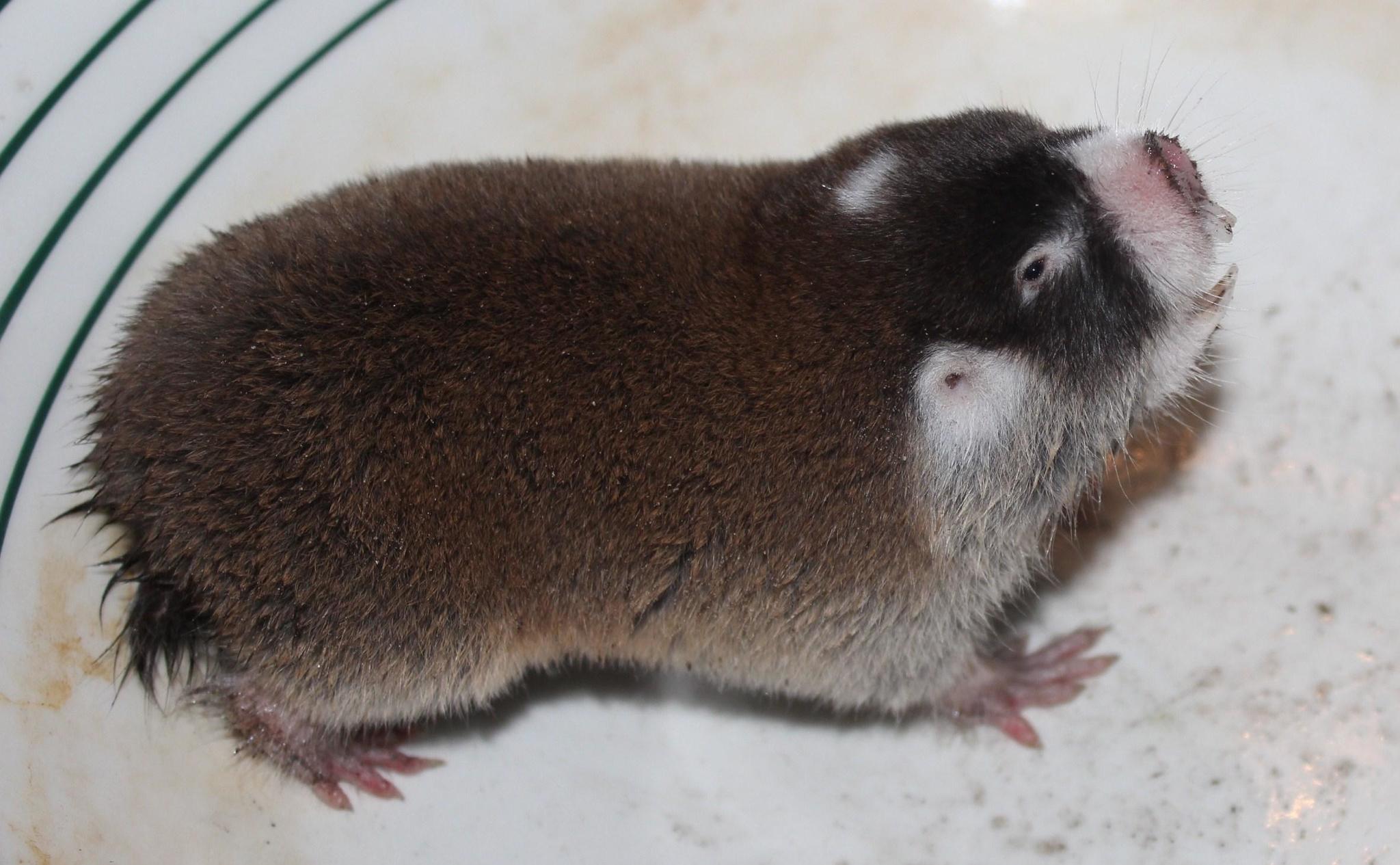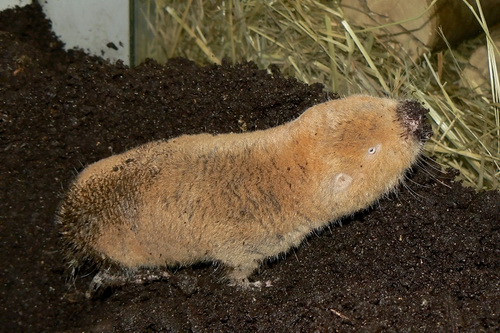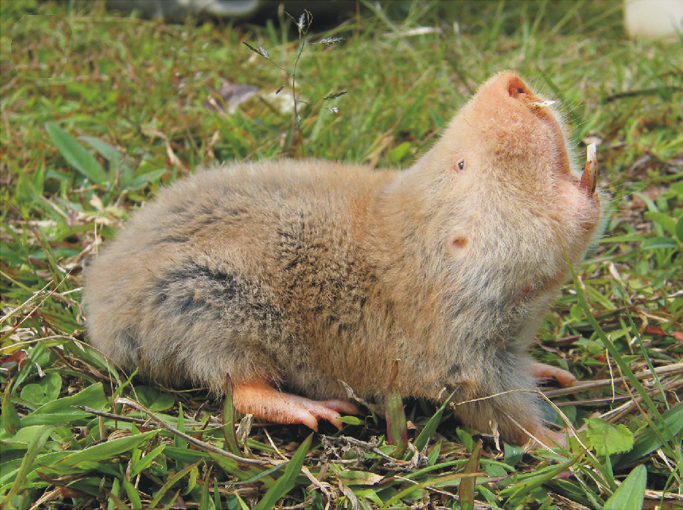Blesmol on:
[Wikipedia]
[Google]
[Amazon]
The blesmols, also known as mole-rats, or African mole-rats, are burrowing


 At present 21 species of blesmols from 5 genera are accepted, but this number is likely to increase. Like other fossorial rodents such as pocket gophers, tuco-tucos, and
At present 21 species of blesmols from 5 genera are accepted, but this number is likely to increase. Like other fossorial rodents such as pocket gophers, tuco-tucos, and 
 subspecies: '' C. h. nimrodi'' - Matabeleland mole-rat
*****subspecies: '' C. h. pretoriae'' - highveld mole-rat
***'' Fukomys''
****'' Fukomys amatus'' - Zambian mole-rat
****'' Fukomys anselli'' - Ansell's mole-rat
****'' Fukomys bocagei'' - Bocage's mole-rat
****'' Fukomys damarensis'' - Damaraland mole-rat
****'' Fukomys darlingi'' - Mashona mole-rat
****'' Fukomys foxi'' - Nigerian mole-rat
****'' Fukomys ilariae'' - Somali striped mole-rat
****'' Fukomys kafuensis'' - Kafue mole-rat
****'' Fukomys mechowii'' - Mechow's mole-rat
****'' Fukomys micklemi'' - Kataba mole-rat
****'' Fukomys ochraceocinereus'' - Ochre mole-rat
****'' Fukomys whytei'' - Malawian mole-rat
*****subspecies: '' F. w. occlusus''
****'' Fukomys zechi'' - Ghana mole-rat
***'' Heliophobius'' - Silvery mole-rat
****'' Heliophobius argenteocinereus'' - Silvery mole-rat
***''
subspecies: '' C. h. nimrodi'' - Matabeleland mole-rat
*****subspecies: '' C. h. pretoriae'' - highveld mole-rat
***'' Fukomys''
****'' Fukomys amatus'' - Zambian mole-rat
****'' Fukomys anselli'' - Ansell's mole-rat
****'' Fukomys bocagei'' - Bocage's mole-rat
****'' Fukomys damarensis'' - Damaraland mole-rat
****'' Fukomys darlingi'' - Mashona mole-rat
****'' Fukomys foxi'' - Nigerian mole-rat
****'' Fukomys ilariae'' - Somali striped mole-rat
****'' Fukomys kafuensis'' - Kafue mole-rat
****'' Fukomys mechowii'' - Mechow's mole-rat
****'' Fukomys micklemi'' - Kataba mole-rat
****'' Fukomys ochraceocinereus'' - Ochre mole-rat
****'' Fukomys whytei'' - Malawian mole-rat
*****subspecies: '' F. w. occlusus''
****'' Fukomys zechi'' - Ghana mole-rat
***'' Heliophobius'' - Silvery mole-rat
****'' Heliophobius argenteocinereus'' - Silvery mole-rat
***''
The Kingdon Field Guide to African Mammals
Academic Press Limited, London. *McKenna, M.C. and S. K. Bell. 1997. Classification of Mammals above the Species Level. Columbia University Press, New York. *Nowak, R. M. 1999. Walker's Mammals of the World, Vol. 2. Johns Hopkins University Press, London. *Seney ML, Kelly DA, Goldman BD, Šumbera R, Forger NG (2009
Social Structure Predicts Genital Morphology in African Mole-Rats.
PLoS ONE 4(10): e7477. doi: 10.1371/journal.pone.0007477
Figure
*Mitgutsch, C., Richardson, M. K., Jiménez, R., Martin, J. E., Kondrashov, P., de, B. M. A., & Sánchez-Villagra, M. R. (January 1, 2012)
Circumventing the polydactyly 'constraint': the mole's 'thumb'.
Biology Letters, 8, 1, 74–7.
rodents
Rodents (from Latin , 'to gnaw') are mammals of the order Rodentia ( ), which are characterized by a single pair of continuously growing incisors in each of the upper and lower jaws. About 40% of all mammal species are rodents. They are n ...
of the family Bathyergidae. They represent a distinct evolution of a subterranean life among rodents much like the pocket gopher
Pocket gophers, commonly referred to simply as gophers, are burrowing rodents of the family Geomyidae. The roughly 41 speciesSearch results for "Geomyidae" on thASM Mammal Diversity Database are all endemic to North and Central America. They ar ...
s of North America, the tuco-tucos in South America, and the Spalacidae
The Spalacidae, or spalacids, are a family of rodents in the large and complex superfamily Muroidea. They are native to eastern Asia, the Horn of Africa, the Middle East, and southeastern Europe. It includes the blind mole-rats, bamboo rats, m ...
from Eurasia.
Distribution
Modern blesmols are found strictly insub-Saharan Africa
Sub-Saharan Africa is the area and regions of the continent of Africa that lie south of the Sahara. These include Central Africa, East Africa, Southern Africa, and West Africa. Geopolitically, in addition to the list of sovereign states and ...
. Fossil
A fossil (from Classical Latin , ) is any preserved remains, impression, or trace of any once-living thing from a past geological age. Examples include bones, shells, exoskeletons, stone imprints of animals or microbes, objects preserve ...
forms are also restricted almost exclusively to Africa
Africa is the world's second-largest and second-most populous continent after Asia. At about 30.3 million km2 (11.7 million square miles) including adjacent islands, it covers 20% of Earth's land area and 6% of its total surfac ...
, although a few specimens of the Pleistocene
The Pleistocene ( ; referred to colloquially as the ''ice age, Ice Age'') is the geological epoch (geology), epoch that lasted from to 11,700 years ago, spanning the Earth's most recent period of repeated glaciations. Before a change was fin ...
species ''Cryptomys asiaticus'' have been found in Israel
Israel, officially the State of Israel, is a country in West Asia. It Borders of Israel, shares borders with Lebanon to the north, Syria to the north-east, Jordan to the east, Egypt to the south-west, and the Mediterranean Sea to the west. Isr ...
. Nowak (1999) also reports that †''Gypsorhychus'' has been found in fossil deposits of Mongolia
Mongolia is a landlocked country in East Asia, bordered by Russia to the north and China to the south and southeast. It covers an area of , with a population of 3.5 million, making it the world's List of countries and dependencies by po ...
.
Anatomy
Blesmols are somewhat mole-like animals with cylindrical bodies and short limbs. They range from in length, and from in weight, depending on the species. Blesmols, like many otherfossorial
A fossorial animal () is one that is adapted to digging and which lives primarily (but not solely) underground. Examples of fossorial vertebrates are Mole (animal), moles, badgers, naked mole-rats, meerkats, armadillos, wombats, and mole salamand ...
mammals, have greatly reduced eyes and ear pinnae, a relatively short tail, loose skin, and (aside from the hairless naked mole rat) velvety fur. Blesmols have very poor vision, although they may use the surfaces of their eyes for sensing air currents. Despite their small or absent pinnae, they have a good sense of hearing, although their most important sense appears to be that of touch
The somatosensory system, or somatic sensory system is a subset of the sensory nervous system. The main functions of the somatosensory system are the perception of external stimuli, the perception of internal stimuli, and the regulation of bo ...
. Like other rodents, they have an excellent sense of smell, and they are also able to close their nostrils during digging to prevent them from clogging with dirt.
The eyes of blesmols are structurally normal, despite their relatively small size, and include normal light-sensitive cells. However, the visual centres of their brains are reduced in certain respects, especially in those centres concerned with localising objects in the visual field. Research has shown that at least two species of blesmol ('' Fukomys mechowii'' and '' Heliophobius argenteocinereus'') are not blind, as commonly believed, and will actively avoid blue or green-yellow light. They do not appear able to detect the presence of red light, and can probably not distinguish between different colours. The ability to sense the presence of light is probably useful in allowing them to detect breaches in their tunnel systems and repair them promptly.
Most blesmol species dig using their powerful incisors
Incisors (from Latin ''incidere'', "to cut") are the front teeth present in most mammals. They are located in the premaxilla above and on the mandible below. Humans have a total of eight (two on each side, top and bottom). Opossums have 18, wher ...
and, to a lesser extent, the foreclaws, although dune blesmols dig primarily with their feet, restricting them to soft, sandy soil. Dune blesmols aside, some species have been reported to be able to extend their burrows by an inch (2.5 cm) into the walls of concrete enclosures. Their unique skull shape is associated with delivering sheer power to the lateral masseter muscle which is responsible for the powerful bite of the anterior portion of the mouth. The incisors of blesmols are projected forward and protrude from the mouth even when the mouth is closed. This condition allows the animals to burrow with their teeth without getting dirt in their mouths. The number of cheek teeth varies greatly between species, an unusual feature among rodents, so that the dental formula for the family is:
Technical characteristics
The skull morphology of blesmols sets them apart from all other rodents. As with all members of their suborder, their jaws are hystricognathous, but, unlike their relatives, they have a highly reduced infraorbital foramen. The medial masseter muscle shows only minimal passage through the infraorbital foramen leading most authorities to consider them protrogomorphous. They are therefore the only protrogomorphous hystricognaths.Behavior
Blesmols live in elaborate burrow systems and different species exhibit varying degrees of sociality. Most species are solitary, but one species, the damaraland blesmol (''Fukomys damarensis'') is one of only twoeusocial
Eusociality ( Greek 'good' and social) is the highest level of organization of sociality. It is defined by the following characteristics: cooperative brood care (including care of offspring from other individuals), overlapping generations wit ...
mammals, the other being the naked mole rat. These species are characterized by having a single reproductively active male and female in a colony where the remaining animals are sterile.
These animals prefer loose, sandy soils and are often associated with arid habitats. They rarely come to the surface, spending their entire life underground. Blesmols are herbivorous, and primarily eat roots, tubers, and bulbs. They are even able to pull smaller plants underground by their roots, without having to leave their burrows, enabling them to eat leaves, stems, and other parts of the plant that would otherwise be inaccessible. Blesmols burrow in search of food, and the great majority of their tunnel complex consists of these foraging burrows, surrounding a smaller number of storage areas, nests, and latrine chambers.
Most species breed only once or twice during the year, although some breed all year round. They generally have small litters of two to five young, perhaps because their environment is sufficiently safe that they do not need to rapidly replace their population as many other rodents do. However, some species have much larger litters, averaging twelve young in the naked mole rat, and sometimes much larger.

Classification
The Bathyergidae are monophyletic, with all taxa tracing back to a single common ancestor. Although there is some controversy, the closest living relatives of the blesmols appear to be other African hystricognaths in the families Thryonomyidae (cane rats) and Petromuridae (dassie rats). Together these three living families along with their fossil relatives represent the infraorder Phiomorpha.
 At present 21 species of blesmols from 5 genera are accepted, but this number is likely to increase. Like other fossorial rodents such as pocket gophers, tuco-tucos, and
At present 21 species of blesmols from 5 genera are accepted, but this number is likely to increase. Like other fossorial rodents such as pocket gophers, tuco-tucos, and blind mole rat
The blind mole-rats, also known as the fossorial or subterranean mole rats, are a subfamily (Spalacinae) of rodents in the family Spalacidae, found in eastern Europe and Western Asia, western and central Asia. The Hystricognathi, hystricognath mo ...
s, blesmols appear to speciate rapidly. They become geographically isolated easily, leading to various chromosomal forms and genetically distinct races. Some studies have suggested that the genus ''Bathyergus
''Bathyergus'' is the genus of dune Blesmol, mole-rats endemic to South Africa. It contains two species :
* Namaqua dune mole-rat - ''B. janetta''
* Cape dune mole-rat - ''B. suillus''
References
Bathyergus,
Bathyergidae
Mammals o ...
'' represents the basal-most lineage; while many researchers had posited that the Naked mole-rat
The naked mole-rat (''Heterocephalus glaber''), also known as the sand puppy, is a burrowing rodent native to the Horn of Africa and parts of Kenya, notably in Somali regions. It is closely related to the blesmols and is the only species in th ...
, '' Heterocephalus'', held that position, more recent investigation has placed that genus in a separate family, Heterocephalidae.
*Family Bathyergidae
**Subfamily Bathyerginae
***'' Georychus'' - cape blesmol
****'' Georychus capensis'' - cape mole-rat
***'' Cryptomys''
****'' Cryptomys hottentotus'' - common mole-rat
*****subspecies: '' C. h. natalensis'' - Natal mole-rat
*****
 subspecies: '' C. h. nimrodi'' - Matabeleland mole-rat
*****subspecies: '' C. h. pretoriae'' - highveld mole-rat
***'' Fukomys''
****'' Fukomys amatus'' - Zambian mole-rat
****'' Fukomys anselli'' - Ansell's mole-rat
****'' Fukomys bocagei'' - Bocage's mole-rat
****'' Fukomys damarensis'' - Damaraland mole-rat
****'' Fukomys darlingi'' - Mashona mole-rat
****'' Fukomys foxi'' - Nigerian mole-rat
****'' Fukomys ilariae'' - Somali striped mole-rat
****'' Fukomys kafuensis'' - Kafue mole-rat
****'' Fukomys mechowii'' - Mechow's mole-rat
****'' Fukomys micklemi'' - Kataba mole-rat
****'' Fukomys ochraceocinereus'' - Ochre mole-rat
****'' Fukomys whytei'' - Malawian mole-rat
*****subspecies: '' F. w. occlusus''
****'' Fukomys zechi'' - Ghana mole-rat
***'' Heliophobius'' - Silvery mole-rat
****'' Heliophobius argenteocinereus'' - Silvery mole-rat
***''
subspecies: '' C. h. nimrodi'' - Matabeleland mole-rat
*****subspecies: '' C. h. pretoriae'' - highveld mole-rat
***'' Fukomys''
****'' Fukomys amatus'' - Zambian mole-rat
****'' Fukomys anselli'' - Ansell's mole-rat
****'' Fukomys bocagei'' - Bocage's mole-rat
****'' Fukomys damarensis'' - Damaraland mole-rat
****'' Fukomys darlingi'' - Mashona mole-rat
****'' Fukomys foxi'' - Nigerian mole-rat
****'' Fukomys ilariae'' - Somali striped mole-rat
****'' Fukomys kafuensis'' - Kafue mole-rat
****'' Fukomys mechowii'' - Mechow's mole-rat
****'' Fukomys micklemi'' - Kataba mole-rat
****'' Fukomys ochraceocinereus'' - Ochre mole-rat
****'' Fukomys whytei'' - Malawian mole-rat
*****subspecies: '' F. w. occlusus''
****'' Fukomys zechi'' - Ghana mole-rat
***'' Heliophobius'' - Silvery mole-rat
****'' Heliophobius argenteocinereus'' - Silvery mole-rat
***''Bathyergus
''Bathyergus'' is the genus of dune Blesmol, mole-rats endemic to South Africa. It contains two species :
* Namaqua dune mole-rat - ''B. janetta''
* Cape dune mole-rat - ''B. suillus''
References
Bathyergus,
Bathyergidae
Mammals o ...
'' - Dune blesmols
****'' Bathyergus janetta'' - Namaqua dune mole-rat
****'' Bathyergus suillus'' - Cape dune mole-rat
Footnotes
References
*Kingdon, J. 1997The Kingdon Field Guide to African Mammals
Academic Press Limited, London. *McKenna, M.C. and S. K. Bell. 1997. Classification of Mammals above the Species Level. Columbia University Press, New York. *Nowak, R. M. 1999. Walker's Mammals of the World, Vol. 2. Johns Hopkins University Press, London. *Seney ML, Kelly DA, Goldman BD, Šumbera R, Forger NG (2009
Social Structure Predicts Genital Morphology in African Mole-Rats.
PLoS ONE 4(10): e7477. doi: 10.1371/journal.pone.0007477
Figure
*Mitgutsch, C., Richardson, M. K., Jiménez, R., Martin, J. E., Kondrashov, P., de, B. M. A., & Sánchez-Villagra, M. R. (January 1, 2012)
Circumventing the polydactyly 'constraint': the mole's 'thumb'.
Biology Letters, 8, 1, 74–7.
External links
{{Authority control Phiomorpha Rodents by common name Extant Miocene first appearances